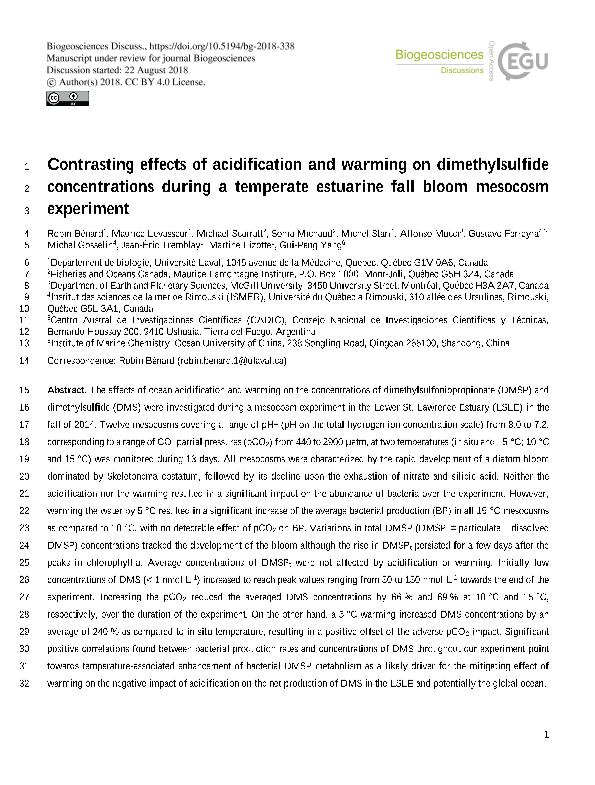Artículo
Contrasting effects of acidification and warming on dimethylsulfide 2 concentrations during a temperate estuarine fall bloom mesocosm 3 experiment
Benard, Robin; Ferreyra, Gustavo Adolfo ; Michael, Scarratt; Sonia, Michaud; Michel, Starr; Alfonso, Mucci; Ferreyra, Gustavo Adolfo
; Michael, Scarratt; Sonia, Michaud; Michel, Starr; Alfonso, Mucci; Ferreyra, Gustavo Adolfo ; Gosselin, Michel; Tremblay, Jean-Éric; Lizotte, Martine; Yang, Gui Peng
; Gosselin, Michel; Tremblay, Jean-Éric; Lizotte, Martine; Yang, Gui Peng
 ; Michael, Scarratt; Sonia, Michaud; Michel, Starr; Alfonso, Mucci; Ferreyra, Gustavo Adolfo
; Michael, Scarratt; Sonia, Michaud; Michel, Starr; Alfonso, Mucci; Ferreyra, Gustavo Adolfo ; Gosselin, Michel; Tremblay, Jean-Éric; Lizotte, Martine; Yang, Gui Peng
; Gosselin, Michel; Tremblay, Jean-Éric; Lizotte, Martine; Yang, Gui Peng
Fecha de publicación:
08/2018
Editorial:
Copernicus Publications
Revista:
Biogeosciences
ISSN:
1726-4170
e-ISSN:
1726-4189
Idioma:
Inglés
Tipo de recurso:
Artículo publicado
Clasificación temática:
Resumen
The effects of ocean acidification and warming on the concentrations of dimethylsulfoniopropionate (DMSP) and dimethylsulfide (DMS) were investigated during a mesocosm experiment in the Lower St. Lawrence Estuary (LSLE) in the fall of 2014. Twelve mesocosms covering a range of pHT (pH on the total hydrogen ion concentration scale) from 8.0 to 7.2, corresponding to a range of CO2 partial pressures (pCO2) from 440 to 2900 μatm, at two temperatures (in situ and C5 °C; 10 and 15 °C) were monitored during 13 days. All mesocosms were characterized by the rapid development of a diatom bloom dominated by Skeletonema costatum, followed by its decline upon the exhaustion of nitrate and silicic acid. Neither the acidification nor the warming resulted in a significant impact on the abundance of bacteria over the experiment. However, warming the water by 5 °C resulted in a significant increase in the average bacterial production (BP) in all 15 °C mesocosms as compared to 10 °C, with no detectable effect of pCO2 on BP. Variations in total DMSP (DMSPt DparticulateCdissolved DMSP) concentrations tracked the development of the bloom, although the rise in DMSPt persisted for a few days after the peaks in chlorophyll a. Average concentrations of DMSPt were not affected by acidification or warming. Initially low concentrations of DMS (< 1 nmol L-1) increased to reach peak values ranging from 30 to 130 nmol L-1 towards the end of the experiment. Increasing the pCO2 reduced the averaged DMS concentrations by 66%and 69%at 10 and 15 °C, respectively, over the duration of the experiment. On the other hand, a 5 °C warming increased DMS concentrations by an average of 240% as compared to in situ temperature, resulting in a positive offset of the adverse pCO2 impact. Significant positive correlations found between bacterial production and concentrations of DMS throughout our experiment point towards temperatureassociated enhancement of bacterial DMSP metabolism as a likely driver of the mitigating effect of warming on the negative impact of acidification on the net production of DMS in the LSLE and potentially the global ocean.
Palabras clave:
acidification
,
warming
Archivos asociados
Licencia
Identificadores
Colecciones
Articulos(CADIC)
Articulos de CENTRO AUSTRAL DE INVESTIGACIONES CIENTIFICAS
Articulos de CENTRO AUSTRAL DE INVESTIGACIONES CIENTIFICAS
Citación
Benard, Robin; Ferreyra, Gustavo Adolfo; Michael, Scarratt; Sonia, Michaud; Michel, Starr; et al.; Contrasting effects of acidification and warming on dimethylsulfide 2 concentrations during a temperate estuarine fall bloom mesocosm 3 experiment; Copernicus Publications; Biogeosciences; 16; 6; 8-2018; 1167-1185
Compartir
Altmétricas



